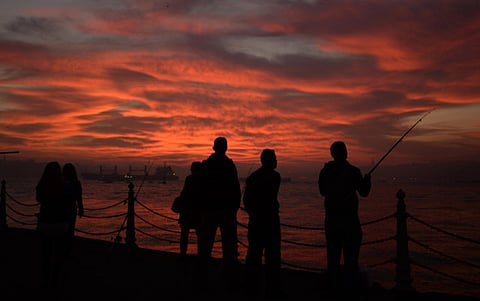5 free things to do in Istanbul
The most pleasurable pastimes cost next to nothing in this Turkish city

Last summer, Istanbul’s Taksim Square was the scene of confrontations between police and protesters. But protests have faded, and contrary to some lingering perceptions, it’s calm now — except for the normal hustle and bustle found in this vibrant city. And it’s as safe for tourists as it ever was.
Istanbul is a thoroughly modern place, but it traces its roots back to 660BC. It’s the former seat of the opulent Byzantine and Ottoman empires and is divided into European and Asian sides by the Bosporus Strait, offering a wealth of history and stunning scenery.
Entry to imperial palaces, museums and most other monuments and sites is not free, and “Istanbul prices” are notoriously higher than the rest of Turkey. Still, residents say that the most pleasurable pastimes in Istanbul — such as walking along the Bosporus or through the Grand Bazaar — cost next to nothing.
Here are five things to do in Istanbul that are free.
Time travel walk
Take an estimated one-hour long walk from Taksim Square into Istiklal Avenue and down to the Galata Bridge for a time-travel experience.
Taksim, considered the city’s main business and entertainment centre, hosts a monument to Turkey’s ubiquitous national hero, Mustafa Kemal Ataturk, and other founders of the modern Turkish Republic.
Istiklal, once home to Christian traders and European diplomats, is still lined with consulates and churches. The bustling area is alive well into the night with street performers, peddlers and music coming from shops and cafés.
Walk past Tunel, the subway line dating back to 1875, to Galata, one of the oldest — now gentrified — neighbourhoods and home to the Galata Tower, a stone medieval observation tower. Walk down to Galata Bridge spanning Istanbul’s Golden Horn waterway past a line of fishermen and take in the thrilling views.
Spice Market and Grand Bazaar
Across the Galata Bridge, on Eminonu Square, is the 17th century Spice Market, or the Egyptian Bazaar, with stalls beautifully displaying spices, dried fruit, nuts, apple tea, essential oils, and “Turkish Delight” candy. Shop owners who will greet you in some 15 different languages, will let you taste the delights for free but try and refuse politely if you are just window shopping.
A 20-minute walk leads to Beyazit Square, home to the 15th century Grand Bazaar. Listed among the United Nations’s World Heritage sites, the Bazaar consists of a maze of covered streets and alleyways with some 4,500 boutiques selling traditional crafts, carpets, leather goods and jewellery. Wander around the crowded alleyways and watch shopkeepers try and woo customers and haggle with shoppers. Visitors are often treated to free tea, especially at carpet shops.
A note of warning: Some shopkeepers can be overly persistent.
Mosques and churches
Istanbul is scattered with religious sites and most of them, particularly Muslim and Christian houses of worship, are free.
There are many to choose from but the Sultanahmet Mosque, better known as the Blue Mosque, in the historic Sultanahmet district should be on top of anyone’s list. The mosque stands out with its six minarets and a cascade of domes, and derives its name from the blue-and-white tiles that decorate the inside.
Suleymaniye Mosque, near Sultanahmet Mosque, built in honour of Sultan Suleyman the Magnificent, is considered one of the masterpieces of the famed Ottoman architect Sinan.
A hidden gem that should not be missed is the 16th century Rustem Pasa Mosque in Eminonu Square near the Spice Market, boasting exquisite floral-design tiles.
Istanbul’s Balat district is home to various Christian churches, including St George’s Church — the main cathedral of the Greek Orthodox Ecumenical Patriarchate — which is open to visitors. Situated on Istiklal Avenue, St Anthony of Padua Church is one of the oldest churches in Istanbul.
Walk along the Bosporus
The narrow waterway — lined with Ottoman palaces and waterside mansions called “yali” — connects the Black Sea to the Sea of Marmara and bisects Istanbul into European and Asian sides.
Scores of large oil tankers, cargo ships, and other vessels sail through the waterway each day. The best stretch for a walk is on the European side of the shore from the small former waterfront village of Ortakoy to the 15th century Ottoman fortress of Rumelihisar.
Walk north towards the Bosporus Bridge to reach the districts of Arnavutkoy (Albanian village) and Bebek (Baby), which boast beautiful promenades and priceless shoreside mansions and houses.
The park above Bebek offers impressive views of the waterway and is a good stop for a picnic. Lucky visitors can sometimes catch a glimpse of dolphins frolicking in the water.
Princes’ Islands
Though visitors have to splurge on a cheap ferry ride (around $2 (Dh7)) to get there, the Princes’ Islands in the Sea of Marmara are a throwback to Turkey’s multicultural past.
Initially a place of exile during the Byzantine era, Turkey’s Christian and Jewish minorities eventually settled on the group of islands making them their home.
The four main islands are today weekend retreats for Turks looking to escape the hustle and bustle of the city. With some exceptions, motor vehicles are not allowed on the islands and the main forms of transport are horse-drawn carriages and bicycles.
Sign up for the Daily Briefing
Get the latest news and updates straight to your inbox



